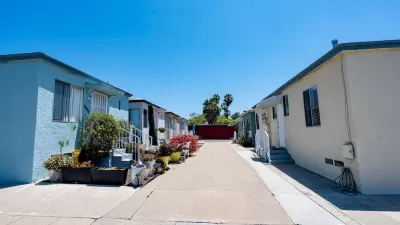Washington State is the latest example of a state that wants to preempt local planning law to make it easier to add housing units to single-family residential properties all over the states.

Dan Bertolet reports on statewide legislation introduced yesterday in Washington by State Representative Nicole Macri (D-Seattle) that would "lift local bans on small-scale, multiple-dwelling homes known as 'middle housing,'"
As explained by Bertolet, HB 2780 would re-legalize, "triplexes on any lot, and up to sixplexes in single-detached house zones in counties and cities of 15,000 or more," as well as, "duplexes on any lot in all cities between 10,000 and 15,000."
HB 2780 joins a growing roster of bills currently under consideration in the Washington Legislature that would ease zoning restrictions and other forms of housing regulation around the state. HB 2570 would ease the construction of backyard cottages and mother-in-law apartments. HB 1923, approved in 2019, increased building capacity around the state, but through incentives rather than a mandate.
HB2780 also joins a growing roster of bills in other states that would preempt local law to allow for more density in single-family zones around the state. Oregon already passed a law, but California, Maryland, Virginia, and Nebraska are considering similar reforms of the traditional single-family zoning designation to allow more space for homes of different sizes in residential neighborhoods.
FULL STORY: WASHINGTON TO CONSIDER RE-LEGALIZING DUPLEXES AND ROWHOUSES STATEWIDE

Trump Administration Could Effectively End Housing Voucher Program
Federal officials are eyeing major cuts to the Section 8 program that helps millions of low-income households pay rent.

Planetizen Federal Action Tracker
A weekly monitor of how Trump’s orders and actions are impacting planners and planning in America.

Ken Jennings Launches Transit Web Series
The Jeopardy champ wants you to ride public transit.

California Invests Additional $5M in Electric School Buses
The state wants to electrify all of its school bus fleets by 2035.

Austin Launches $2M Homelessness Prevention Fund
A new grant program from the city’s Homeless Strategy Office will fund rental assistance and supportive services.

Alabama School Forestry Initiative Brings Trees to Schoolyards
Trees can improve physical and mental health for students and commnity members.
Urban Design for Planners 1: Software Tools
This six-course series explores essential urban design concepts using open source software and equips planners with the tools they need to participate fully in the urban design process.
Planning for Universal Design
Learn the tools for implementing Universal Design in planning regulations.
Ada County Highway District
Clanton & Associates, Inc.
Jessamine County Fiscal Court
Institute for Housing and Urban Development Studies (IHS)
City of Grandview
Harvard GSD Executive Education
Toledo-Lucas County Plan Commissions
Salt Lake City
NYU Wagner Graduate School of Public Service





























